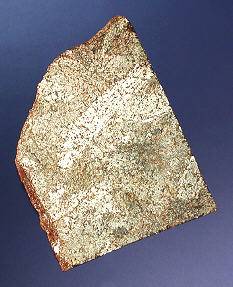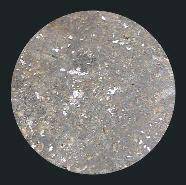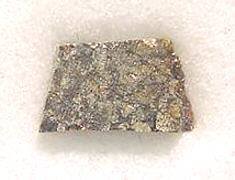Shallowater
Enstatite achondriteUsed in past as synonym for Aubrites. Present definition from the Meteoritical Bulletin states that this rare class is an "enstatite-rich achondrite that has not yet been classified into a group". Click on Term to Read More, ungroupedModifying term used to describe meteorites that are mineralogically and/or chemically unique and defy classification into the group or sub-group they most closely resemble. Some examples include Ungrouped Achondrite (achondrite-ung), Ungrouped Chondrite (chondrite-ung), Ungrouped Iron (iron-ung), and Ungrouped Carbonaceous (C-ung). Click on Term to Read More
(impact melt rockRock that has been made temporarily molten as a result of the energy released by the impact of a large colliding body. Impact melts include small particles, known as "impact melt spherules" that are splashed out of the impact crater, and larger pools and sheets of melt that collect in Click on Term to Read More, anomalous aubriteAubrites are named for the Aubres meteorite that fell in 1836 near Nyons, France. They are an evolved achondrite that is Ca-poor and composed mainly of enstatite (En100) and diopside (En50Wo50) with minor amounts of olivine (Fa0) and traces of plagioclase (An2-8). They contain large white crystals of enstatite as Click on Term to Read More)
Found July, 1936
33° 42′ N., 101° 56′ W.
- The first stage reflects rapid cooling (supercooling) from a melt temperature of ~1580°C to ~712°C. This is consistent with the collisional breakup of a differentiated body, consisting primarily of an enstatite melt phase, as a result of an impact with a solid enstatite-like object. The disruption and incorporation of cold impactor material into enstatite melt resulted in very rapid quenching. This was a low-velocity collision that permitted the gravitational reassembly of the disrupted body and the incorporation of xenolithic material from the solid body.
- Cooling rate data indicate that a long period of very slow cooling was then initiated which lasted for several million years, until temperatures reached ~680°C. This reflects the deep burial (e.g. 40 km deep on a 100 km-diameter body) of the Shallowater rock within the rubble-pile.
- A final stage of fast cooling to ~300°C commenced following another impact event. This incident excavated the Shallowater rock to within ~5 m of the asteroid surface, possibly through a second breakup and reassembly event, or to within ~5 m of the surface of an ejected fragment.
The sizes of the differentiated Shallowater and aubrite parent bodies are constrained by those processes which led to their melting. Arguments suggesting that the heat source was the decay of short-lived radionuclides like 26Al have not been reconciled with the apparent low Al and plagioclase contents in Shallowater and the aubrites. In a similar manner, John T. Wasson (2016) presented evidence that the slow heating generated entirely by the decay of 26Al is insufficient to melt asteroids, and that an additional heat source would have been required; e.g., the rapid heating incurred from major impact events. He determined that the canonical 26Al/27Al ratio of 0.000052 is much too low to cause any significant melting, and that a minimum ratio of 0.00001 would be required to produce a 20% melt fraction on a well-insulated body having a significant concentration of 26Al. For example, the initial ratio of 0.0000004–0.0000005 calculated for the angrites Sah 99555 and D’Orbigny based on their 26Al–26Mg isochrons is too low to have generated any significant melting without an additional heat source. Some have suggested that relatively small planetesimalsHypothetical solid celestial body that accumulated during the last stages of accretion. These bodies, from ~1-100 km in size, formed in the early solar system by accretion of dust (rock) and ice (if present) in the central plane of the solar nebula. Most planetesimals accreted to planets, but many – Click on Term to Read More might have been just the required size to allow heating by induction in the plasmaFourth state of matter: a gas in which many or most of the atoms are ionized. In the plasma state the atoms have split into positive ions and negative electrons, which can flow freely, so the gas becomes electrically conducting and a current can flow. Click on Term to Read More environment of the T Tauri SunOur parent star. The structure of Sun's interior is the result of the hydrostatic equilibrium between gravity and the pressure of the gas. The interior consists of three shells: the core, radiative region, and convective region. Image source: http://eclipse99.nasa.gov/pages/SunActiv.html. The core is the hot, dense central region in which the.
In studies of the I–Xe systemDefinable part of the universe that can be open, closed, or isolated. An open system exchanges both matter and energy with its surroundings. A closed system can only exchange energy with its surroundings; it has walls through which heat can pass. An isolated system cannot exchange energy or matter with of the Shallowater and EL parent bodies, evidence was obtained that both bodies experienced a similar period of heavy bombardment that was concordant in time, suggesting that they formed in a similar region of the Solar SystemThe Sun and set of objects orbiting around it including planets and their moons and rings, asteroids, comets, and meteoroids. 4.566 (±0.002) b.y. ago (Brazzle et al., 1999); this precise I–Xe closure isochron of Shallowater enstatite was subsequently adopted as a reference standard for calibation of the I–Xe technique against the Pb–Pb chronometer. Since then, a new absolute age for the closure of Shallowater enstatite was calculated by Gilmour et al. (2006) based on the I–Xe and Pb–Pb systems to be 4.5633 (±0.0004) b.y., and this was further refined by Gilmour et al. (2009) to be 4.5623 (±0.0004) b.y., which is 1 m.y. earlier than previously determined. A succeeding high precision isotopic study conducted by Pravdivtseva et al. (2016) led them to suggest a further refinement of the absolute I–Xe age to 4.5624 (±0.0002) b.y. Additional data points based on I–Xe studies of Ibitira and NWA 7325 have now been merged into the Shallowater calibration, resulting in a new absolute closure age of 4.5627 (±0.0003) b.y., which is 0.3 m.y. older than the previous calculation (Gilmour and Crowther, 2016 and references therein). Radiometric dating techniques utilizing 39Ar–40Ar data have determined an average degassing age of 4.53 b.y, likely representing an intense impact event. This is similar to Ar–Ar ages determined for some EH and EL meteorites such as Happy Canyon, but still older than for others, which suggests that the complex cooling history of Shallowater occurred very early after its formation. The CRE age of Shallowater is 28 (±4) m.y., which forms a cluster with the anomalous aubrites Mt. Egerton and Happy Canyon, as well as the normal aubrite ALHA78113 (and pairings). A study of H–W systematics in various aubrites was conducted by Petitat et al. (2008). They found that in contrast to all other aubrites studied, metalElement that readily forms cations and has metallic bonds; sometimes said to be similar to a cation in a cloud of electrons. The metals are one of the three groups of elements as distinguished by their ionization and bonding properties, along with the metalloids and nonmetals. A diagonal line drawn Click on Term to Read More in Shallowater has an unradiogenic W isotopic composition more similar to that in ordinary chondritesChondrites are the most common meteorites accounting for ~84% of falls. Chondrites are comprised mostly of Fe- and Mg-bearing silicate minerals (found in both chondrules and fine grained matrix), reduced Fe/Ni metal (found in various states like large blebs, small grains and/or even chondrule rims), and various refractory inclusions (such Click on Term to Read More. They argue that Shallowater therefore could not have experienced the late heating event(s) which caused radiogenic W diffusionMovement of particles from higher chemical potential to lower chemical potential (chemical potential can in most cases of diffusion be represented by a change in concentration). Diffusion, the spontaneous spreading of matter (particles), heat, or momentum, is one type of transport phenomena. Because diffusion is thermally activated, coefficients for diffusion Click on Term to Read More into metal. On an oxygen 3-isotope diagram, the O-isotopic composition of Shallowater is indistinguishable from that of the aubrites and the EL chondrites. Interestingly, the EH chondrites define a slightly steeper slope, an anomaly that may reflect parent body metamorphism (Newton, 2000). Since the REEOften abbreviated as “REE”, these 16 elements include (preceded by their atomic numbers): 21 scandium (Sc), 39 Yttrium (Y) and the 14 elements that comprise the lanthanides excluding 61 Promethium, an extremely rare and radioactive element. These elements show closely related geochemical behaviors associated with their filled 4f atomic orbital. Click on Term to Read More abundances measured in plagioclase were too low to account for the bulk REE content of Shallowater, a better candidate for the REE carrier was sought. The discovery of trace amounts of oldhamite provided the answer; it was proposed that the weathering products of oldhamite were now the carriers of much of the bulk REE (Heavilon, 1989). Petrologic, mineralogic, and geochemical investigations relating to Shallowater have ruled out an igneous or impact-melt origin on the aubrite parent body, as well as an impact-melt origin on the EH or EL parent bodies, and it is presumed that it represents a fourth enstatite parent body. The Kr and Xe noble gasElement occurring in the right-most column of the periodic table; also called "inert" gases. In these gases, the outer electron shell is completely filled, making them very unreactive. Click on Term to Read More isotopic compositions are Q-like (see the Yilmia page for further details about Q-gases), and are considered to be primordial due to the unbrecciated nature of the meteoriteWork in progress. A solid natural object reaching a planet’s surface from interplanetary space. Solid portion of a meteoroid that survives its fall to Earth, or some other body. Meteorites are classified as stony meteorites, iron meteorites, and stony-iron meteorites. These groups are further divided according to their mineralogy and Click on Term to Read More (Miura et al., 2006). The photo shown above is a 0.574 g specimen of Shallowater, which was sectioned from the 50.54 g partial slice shown below.
Photo courtesy of the Macovich Collection The two photos shown below provide high resolution close-up views of both a prepared and an unprepared face of a Shallowater section (note the reflective free-metal inclusions conspicuous in the prepared face).


click on image for a magnified view Photography by R. Elliott—Fernlea Meteorites UK







